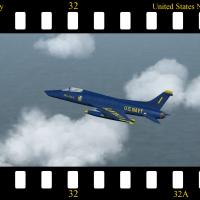-
Content count
9,300 -
Joined
-
Last visited
-
Days Won
497
Content Type
Profiles
Forums
Calendar
Gallery
Downloads
Store
Everything posted by Spinners
-

Super Furies with the Blue Angels
Spinners posted a topic in Thirdwire: Strike Fighters 2 Series - Sci-Fi/Anime/What If Forum
North American F2J-1A Super Fury - 'Blue Angels', United States Navy, 1959 Nice one Daniel! -

Super Furies with the Blue Angels
Spinners replied to Spinners's topic in Thirdwire: Strike Fighters 2 Series - Sci-Fi/Anime/What If Forum
-
Version Version 1
86 downloads
North American F2J-1A Super Fury for STRIKE FIGHTERS 2 This is a very simple mod of Cocas' recent Super Fury to represent the F2J-1A as it might have appeared in service with the 'Blue Angels' aerobatic display team. INSTRUCTIONS 1. From the AIRCRAFT folder drag and drop the F2J-1A folder into your main Aircraft folder. 2. From the DECALS folder drag and drop the F2J-1A folder into your main Decals folder. 3. From the PILOTS folder drag and drop the PILOT_BA folder into your main Pilots folder. CREDITS Thanks to Cocas for bringing us another 'what if' paper project. I love them! As always, thanks to Third Wire for a great little game/sim and for the 'Blue Angels' number decals. Regards Spinners Version 1 - 23/12/15 -

Panslavic War
Spinners replied to Gepard's topic in Thirdwire: Strike Fighters 2 Series - Mission & Campaign Building Discussion
Very good backstory. -

What If Screenshot Thread.......
Spinners replied to Dave's topic in Thirdwire: Strike Fighters 2 Series - Screen Shots
-

What If Screenshot Thread.......
Spinners replied to Dave's topic in Thirdwire: Strike Fighters 2 Series - Screen Shots
No 69 (Story of my life) -

Strike Fighters 2 Screenshots
Spinners replied to Dave's topic in Thirdwire: Strike Fighters 2 Series - Screen Shots
Er, Rata -

Super Furies with the Blue Angels
Spinners replied to Spinners's topic in Thirdwire: Strike Fighters 2 Series - Sci-Fi/Anime/What If Forum
-

What If Screenshot Thread.......
Spinners replied to Dave's topic in Thirdwire: Strike Fighters 2 Series - Screen Shots
Airshow '59 -

Strike Fighters 2 Screenshots
Spinners replied to Dave's topic in Thirdwire: Strike Fighters 2 Series - Screen Shots
Stealth! -

Super Furies with the Blue Angels
Spinners replied to Spinners's topic in Thirdwire: Strike Fighters 2 Series - Sci-Fi/Anime/What If Forum
I don't think you need to - it was a nice present inside the download! -

Super Furies with the Blue Angels
Spinners replied to Spinners's topic in Thirdwire: Strike Fighters 2 Series - Sci-Fi/Anime/What If Forum
Thank you. I wasn't too sure but gave it a go. -

Spey Phantoms with the Jayhawks
Spinners replied to Spinners's topic in Thirdwire: Strike Fighters 2 Series - Sci-Fi/Anime/What If Forum
Deployment to Korea -

'Pueblo Incident' Starfighters
Spinners replied to Spinners's topic in Thirdwire: Strike Fighters 2 Series - Sci-Fi/Anime/What If Forum
It's just a tweaked RDAF skin with some black tail codes applied to the 'C'. A similar job could be done with the 'G' with the RDAF skin (or CF-104 green) and the USAF markings in my 'what if' F-104E. http://combatace.com/topic/71650-lockheed-f-104e/ http://combatace.com/topic/71692-fictional-lockheed-f-104e-starfighter-ang/ -

WW2 Screenshots Thread
Spinners replied to Wrench's topic in Thirdwire: Strike Fighters 2 Series - Screen Shots
Mongrels -

Help avoid missiles
Spinners replied to matanbar123's topic in Thirdwire: Strike Fighters 2 Series - General Discussion
Fly before 1956... -

What If Screenshot Thread.......
Spinners replied to Dave's topic in Thirdwire: Strike Fighters 2 Series - Screen Shots
F-104C - 435th Tactical Fighter Squadron, 1968 -

Strike Fighters 2 Screenshots
Spinners replied to Dave's topic in Thirdwire: Strike Fighters 2 Series - Screen Shots
The Original G -

Strike Fighters 2 Screenshots
Spinners replied to Dave's topic in Thirdwire: Strike Fighters 2 Series - Screen Shots
Moon Shot -

What If Screenshot Thread.......
Spinners replied to Dave's topic in Thirdwire: Strike Fighters 2 Series - Screen Shots
Cold War: Flashpoint Korea -

Strike Fighters 2 Screenshots
Spinners replied to Dave's topic in Thirdwire: Strike Fighters 2 Series - Screen Shots
Patrolling Pair -

'Blue Diamonds' Thunderstreaks
Spinners posted a topic in Thirdwire: Strike Fighters 2 Series - Sci-Fi/Anime/What If Forum
Republic F-84M Thunderstreak FGA.2 - No.92 Squadron 'Blue Diamonds', RAF Fighter Command, 1956- 1 reply
-
- 3
-

-

Strike Fighters 2 Screenshots
Spinners replied to Dave's topic in Thirdwire: Strike Fighters 2 Series - Screen Shots
-

What If Screenshot Thread.......
Spinners replied to Dave's topic in Thirdwire: Strike Fighters 2 Series - Screen Shots
A brace of Blue Diamonds -

What If Screenshot Thread.......
Spinners replied to Dave's topic in Thirdwire: Strike Fighters 2 Series - Screen Shots
Normandy 1946: Warthog over the Bocage

